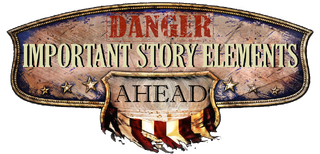The Wounded Knee Massacre, sometimes called the "Battle of Wounded Knee", was an atrocity carried out by the U.S. Army against the Lakota people on December 29, 1890. It forever scarred Booker DeWitt, who participated in the massacre.
In late 1890, a popular movement known as Ghost Dancing had resurfaced among the Lakota tribes of the Midwestern United States. The movement advocated, among other things, the return to Native American culture and pride as well as the expulsion (or destruction) of the European invaders by God. The Ghost Dance movement arose from the destruction of the tribe's culture and the US Congress'a failure to uphold the treaties they had signed (often over the protests of US Army and government officials in the local area) that were leading to slow starvation of the tribe. One US Government Indian Agent and some settlers feared the movement could inspire an uprising and US Army forces, including the 7th Calvary, were dispatched to prevent this by seizing the Lakota’s weapons despite nothing actually happening.
Following a confrontation with Indian Agency Police that killed prominent Lakota chief Sitting Bull, roughly 350 Lakota fled to a camp further north. They were intercepted by a unit of the 7th Calvary and directed to camp near Wounded Knee Creek. The rest of the unit arrived and took up positions on hills surrounding the camp. At the time the 7th had four Hotchkiss mountain guns, a light artillery gun. A detachment was dispatched to impound the weapons from the tribe. During this operation, a weapon accidentally discharged and the Army forces on the surrounding hills opened fire on the camp seemingly without orders. The badly outnumbered and outgunned Lakota tried to defend themselves but didn’t stand a chance. Unarmed men, women and children were cut down by fire from the hills. Survivors attempted to flee but were hunted down and slaughtered by the rampaging soldiers. Some bodies were found miles away from the camp.
Corporal Booker Dewitt (who was only 16 years old at the time and in the Army illegally) took part in the slaughter, setting tipis (teepees) on fire while they was still occupied and scalping the dead earning him the nickname “White Injun”. In the end an estimated 250 to 300 Lakota were dead along with 31 US Soldiers. While given awards for his actions, Booker was overcome by guilt and showed signs of what is today known as Post-Traumatic Stress Disorder. He soon left the Army with a separation rank of Staff Sergeant. Some time after, Booker would encounter Preacher Witting and start to partake in a baptism to wash away his sins. In one reality Booker ends up rejecting this baptism believing that he could not just wash away the crimes he had committed. In another reality he accepted the baptism and became Zachary Hale Comstock. Comstock would soon become a powerful religious leader with cult like following. With the technology of Rosalind Lutece he would have the floating City of Columbia constructed. At some point Father Comstock had a museum called the Hall of Heroes created which contained a sizable section dedicated to Wounded Knee. This large exhibit created a false narrative that portrayed the massacre as a noble battle against savages and that Comstock had commanded the 7th Calvary at the time. Booker DeWitt would later encounter Cornelius Slate, another veteran of Wounded Knee, in the Hall of Heroes while trying to escape Columbia with Elizabeth.

